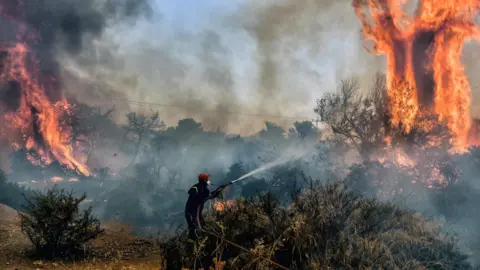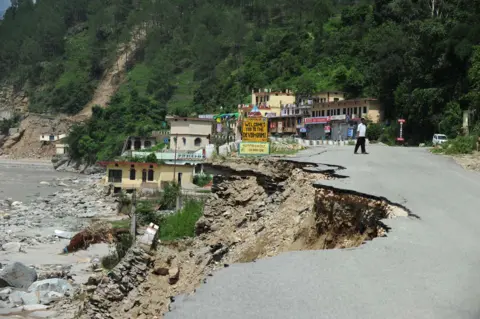
 Getty Images
Getty ImagesHuman-caused climate change made the ten deadliest extreme weather events of the last 20 years more intense and more likely, according to new analysis.
The killer storms, heatwaves and floods affected Europe, Africa and Asia killing more than 570,000 people.
The new analysis highlights how scientists can now discern the fingerprint of climate change in complex weather events.
The study involved reanalysing data for some of the extreme weather events and was carried out by scientists from the World Weather Attribution (WWA) group at Imperial College London.
“This study should be an eye-opener for political leaders hanging on to fossil fuels that heat the planet and destroy lives”, said Dr Friederike Otto, co-founder and lead of WWA.
“If we keep burning oil, gas and coal, the suffering will continue,” she said.
 Getty Images
Getty ImagesThe researchers focused on the 10 deadliest weather events registered in the International Disaster Database since 2004. That was when the first study was published linking a weather event – a heatwave in Europe – with our changing climate.
The deadliest event of the last two decades was a drought in Somalia in 2011 which is reckoned to have killed more than 250,000 people. The researchers found the low rainfall that drove the drought was made more likely and more extreme by climate change.
The list includes the heatwave that hit France in 2015 killing more than 3,000 people, where researchers say high temperatures were made twice as likely because of climate change.
It also contains the European heatwaves of 2022, when 53,000 people died, and 2023, which led to 37,000 people losing their lives. The latter would have been impossible without climate change, the study finds.
It says the deadly tropical cyclones that hit Bangladesh in 2007, Myanmar in 2008 and the Philippines in 2013 were all made more likely and intense by climate change. That was also the case with the floods that hit India in 2013.
The researchers say the real death toll from these events is likely to be significantly higher than the figures they quote.
That is because fatalities linked to heatwaves do not tend to be recorded as such in much of the world, especially in poorer nations which are most vulnerable.
The study was carried out before the storms in Spain left dozens dead this week.
 Getty Images
Getty ImagesThe link between climate change and weather events is only possible because the two scientists who founded the WWA – Dr Otto and a Dutch climatologist called Geert Jan van Oldenborgh – pioneered a way to track global warming in catastrophic weather events.
They knew that weather records showed that extreme weather events were becoming more intense. What’s more, a huge body of peer-reviewed science explained how warming the atmosphere can intensify extreme weather. What was missing was the link between a single event to rising global temperatures.
For years forecasters have been using atmospheric models to predict future weather patterns. Otto and Oldenborgh repurposed the models to run repeated simulations to work out how likely a weather event was in the current climate.
They also created parallel simulations which explored how likely the same event was in a world in which the industrial revolution had never happened. These computer models stripped out the effects of the billions of tonnes of CO2 that humans have pumped into the atmosphere.
The calculations meant they could compare how likely the same event was with and without the 1.2C of global warming that the world has already experienced since the industrial revolution.
“The massive death tolls we keep seeing in extreme weather shows we are not well prepared for 1.3°C of warming, let alone 1.5°C or 2°C”, said Roop Singh, of the Red Cross Red Crescent Climate Centre which supports the WWA.
She said today’s study showed the need for all countries to build their resilience to climate change and warned: “With every fraction of a degree of warming, we will see more record-breaking events that push countries to the brink, no matter how prepared they are.”







